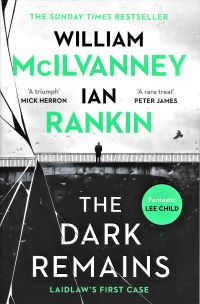BOGOF value in two-author tartan noir mystery thriller
There is a new game afoot among crime fiction afficionados. Especially those who believe there’s nothing to match the rapidly expanding sector known as tartan noir.
It is called Spot the Join. Or Find the Seam. Even Detect the Author. Or any of the many possible similar phrases.
My own variation on this theme is Where’s the Rankin?
Any number can play and the rules are simple: obtain a copy of The Dark Remains (Canongate Books, paperback, 2022) and decide where today’s supreme master of Scottish crime fiction, Ian Rankin, takes over from William McIlvanney, the maestro who inspired Rankin into a life of “crime”.
I am not generally a fan of books written “in the style of” authors who have breathed their last. Not even if they have been given the blessing and go-ahead of the original writer’s heirs and administrators.
The idea, presumably, is to ensure the writer’s name lives on – and, of course, continues to churn out royalties for their estate.
Go write your own books, say I, and let us savour the real thing unsullied by your variation on a theme.
But The Dark Remains is a welcome exception. This is no ghost writer’s plaything but an homage to one of the greats of crime fiction by the one who now wears his mantle.
McIlvanney arrived on the scene in 1977 with the publication of Laidlaw, his eponymous detective, and was generally hailed as an innovator.
This gritty procedural broke new ground. It took crime fiction, and its lead characters, into totally new territory.
It delved deep into the criminal underbelly of Laidlow’s home turf, the gritty rough-hewn city of Glasgow. It also led to all that followed from Scottish crime writers being corralled into a new genre labelled tartan noir.
Two more Laidlaw books followed to complete the triology. Only after McIlvanney’s death in 2015 was an unfinished manuscript for a fourth Laidlaw book discovered.
It is this late find, The Dark Remains, that was handed to McIlvanney admirer and widely acknowledged successor, Ian Rankin, for completion.
And who could be better suited to the task of treading in the footsteps of a sardonic no-nonsense law enforcer battling the hoodlums of Glasgow than the writer whose own latter-day hero, John Rebus, has long been performing much the same role in nearby Edinburgh?
It was a no-brainer. Peas in a pod. A marriage if not made in heaven at least consummated amid the brutal and devious machinations of Scotland’s criminal maze.
The result is a gripping tale as seamless as the invisible mending offered by clothiers, tailors and their ilk. Where McIlvanney ends and Rankin takes over is impossible to detect.
The “voice” is constant throughout. Dry, terse and brittle. And always laced with a hint of a soft centre and a dash or two of blunt humour.
Although this is the last of McIlvanney’s books to be published, it is the first to feature Laidlaw. It pre-dates the trilogy.
This is where a legend began – in the year 1979 as two of Glasgow’s notorious gangs are on the verge of open warfare.
Yet nothing is dated apart from the background. And that comes across as an authentic backdrop to a rich cast of characters set on a deadly course of “it’s them or us”.
Detective Jack Laidlaw is newly appointed to the local crime squad. He has little time for old allegiances (especially those between his colleagues and the gang bosses) and ploughs his own relentless furrow.
Loyalties are ignored, feathers are ruffled. Someone always pays the price, brutally and sometimes fatally.
Conversations are brief, sharp and sardonic. Cynicism is Laidlaw’s byword, trusting no one and seeding doubts and duplicity among his foes.
The characters and the city are vividly depicted. The twists and turns come at a rapid pace. Nothing and no one are quite as they seem.
It is a tale that demands to be read at a single sitting until the guilty ones are unmasked.
And overall lies that other mystery: which is McIlvanney and which is Rankin? A must read for all crime fiction fans.

